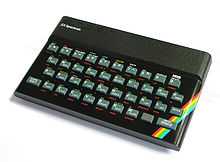Timex Computer 2048
From Wikipedia, the free encyclopedia
- This article is about the Timex Computer 2048 (TC 2048). For the similarly named but different ZX Spectrum-variant prototype intended for sale in North America, see Timex Sinclair 2048 (TS 2048).
 | |
| Type | Home computer |
|---|---|
| Release date | 1984 |
| Discontinued | 1989 |
| Operating system | Sinclair BASIC |
| CPU | Zilog Z80A @ 3.5 MHz |
| Memory | 48 KB |
The TC 2048 or Timex Computer 2048 is a computer created by "Timex of Portugal, Lda", a branch of Timex Corporation.
It was highly compatible with the Sinclair ZX Spectrum computer, although differences in the ROM prevented 100% compatibility.
Timex Portugal sold the TC 2048 in Portugal and Poland, where it was very successful. Also, a NTSC version was sold in Chile. This computer forms the basis of an improved Spectrum-compatible machine, the Spectrum SE.
Technical specifications
- Zilog Z80A @ 3.50 MHz
- 16 KB
- 48 KB
Display
- Improved ULA offering additional screen modes:
- Text: 32×24 characters (8×8 pixels, rendered in graphics mode)
- Graphics: 256×192 pixels, 15 colours (two simultaneous colours - "attributes" - per 8×8 pixels, causing attribute clash)
- Extended Color: 256×192 pixels, 15 colors with colour resolution of 32×192 (two simultaneous colours - "attributes" - per 1×8 pixels)
- Dual Screen: (two 256×192 pixels screens can be placed in memory)
- A monochrome 512×192 mode
Sound
- Beeper (1 channel, 10 octaves and 10+ semitones via internal speaker)
[By separate purchase the Joystick/Sound Unit was available to enhance sound and provide a joystick port.]
I/O
- Z80 bus in/out
- Tape audio in/out for external cassette tape storage
- RF television out
- Composite video monitor out
- Kempston Joystick input
Storage
- External cassette tape recorder
- 1–8 external ZX Microdrives (using ZX Interface 1)
- Timex FDD (Floppy Disk Drive System Power Supply, Controller and Disk Drive in separate cases. 16K RAM, Timex Operating System (TOS))
- Timex FDD3000 (Enhanced version (all in one case) of the Timex FDD but upgraded to 64K RAM & TOS with two Hitachi 3″ disk drives)
See also
External links
| ||||||||||||||||||||||||||||
This article is issued from Wikipedia. The text is available under the Creative Commons Attribution/Share Alike; additional terms may apply for the media files.
